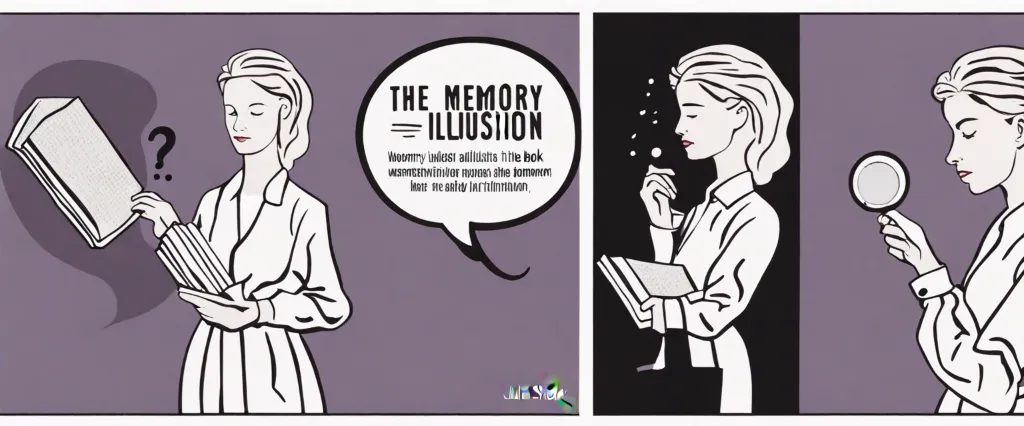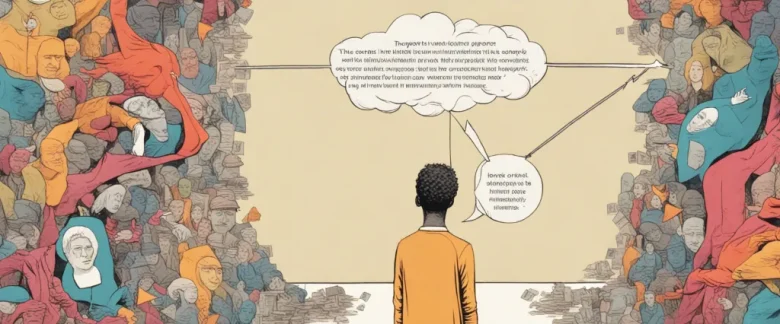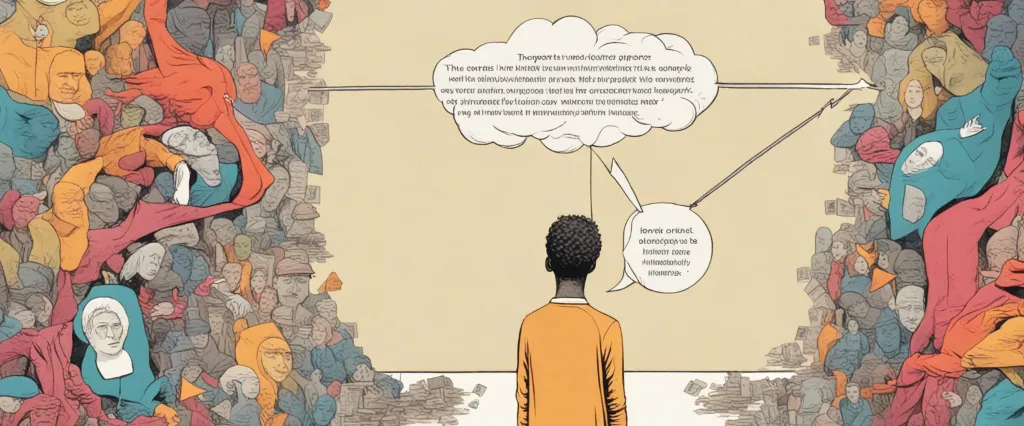In “The Memory Illusion,” Julia Shaw unravels the complex web of our memories, revealing the shocking truth that even the most vivid recollections can be misleading or entirely fabricated. Drawing from her background in psychology and neuroscience, Shaw guides readers on a captivating journey that challenges our long-held beliefs about the accuracy and reliability of our memory. With meticulous research and engaging storytelling, she exposes the illusion of memory and explores its profound implications. As a renowned memory expert and a professor at University College London, Julia Shaw brings her expertise to the forefront, shedding light on the mysteries of our minds and inviting readers to question the very nature of their own memories.
Chapter 1: Introduction to Memory
Chapter 1 of The Memory Illusion by Julia Shaw provides an introduction to the concept of memory and highlights the common misconceptions surrounding its reliability. Shaw begins by sharing the iconic quote from George Orwell’s novel “1984” – “Who controls the past controls the future: who controls the present controls the past” – emphasizing the power of memory in shaping our lives.
The chapter then delves into the fallibility of memory by presenting an experiment involving participants witnessing a staged crime. The study found that individuals were easily swayed and manipulated in their recollection of the event through suggestive questioning. Shaw exposes the susceptibility of memory to external influences and highlights the potential for false memories to be inadvertently implanted.
She further explores the reconstructive nature of memory, explaining that instead of functioning like a video recorder, memory is more like a set of impressions pieced together to create a narrative. Our memories are influenced by knowledge, beliefs, and biases, which can lead to distortions and inaccuracies.
Shaw goes on to discuss the implications of false memories in various contexts, such as eyewitness testimonies in criminal trials and instances of recovered memories in therapy. She emphasizes the potential dangers of relying on memories as unquestionable truth and underscores the need for a critical understanding of memory’s limitations.
In conclusion, Chapter 1 sets the stage for the book’s exploration of memory, challenging readers to question the accuracy and reliability of their own recollections. Through captivating examples and scientific studies, Shaw invites us to reconsider the nature of memory and the powerful influence it has on our lives.
Chapter 2: The Constructive Nature of Memory
Chapter 2 of “The Memory Illusion” by Julia Shaw is titled “The Constructive Nature of Memory” and delves into the complexities and fallacies of human memory. Shaw explores the fundamental idea that our memories are not static reproductions of past events but are constantly changing constructs influenced by various factors.
The chapter begins with a case study of Jennifer Thompson, a woman who confidently identified Ronald Cotton as her rapist, leading to his conviction. However, years later, DNA evidence exonerated Cotton, revealing that Thompson’s memory had been highly fallible. This case serves as a powerful example of how memory can be constructed and modified over time.
Shaw introduces the concept of schemas, mental frameworks or structures that organize our knowledge and expectations. Schemas influence our perception and memory by shaping how we encode, store, and retrieve information. They can fill in gaps, alter details, or even create entirely false memories. This malleability stems from the fact that memory retrieval involves a reconstruction process rather than a simple playback of events.
The chapter also explores the power of suggestion in shaping memory. Shaw discusses experiments carried out by renowned psychologists Elizabeth Loftus and John Palmer, which demonstrated how leading questions can alter eyewitness testimony. Subtle changes in the wording of questions can significantly influence people’s recollections, further illustrating the susceptibility of memory to external influences.
Furthermore, the chapter delves into the idea of confabulation, where individuals unknowingly fabricate information to fill in memory gaps. Confabulation can occur due to genuine gaps in memory or as a result of social pressure or the desire to provide a coherent narrative. Shaw emphasizes that these memory distortions are not intentional lies but genuine beliefs held by the individual.
Overall, Chapter 2 of “The Memory Illusion” highlights memory’s constructive nature, emphasizing the importance of being aware of its fallibilities. Our memories are not reliable records of past events but rather fluid representations influenced by various factors, ultimately leading to the potential for both accurate and false recollections.
Chapter 3: Eyewitness Testimony
Chapter 3 of “The Memory Illusion” by Julia Shaw delves into the topic of eyewitness testimony. Shaw argues that memories are not as reliable as we perceive them to be, especially when it comes to remembering events accurately. This chapter focuses on understanding the fallibility of eyewitness testimony and explores various factors that can influence the accuracy of memory recall.
Shaw begins by discussing the confidence people often place in their own memories and how this can lead to false beliefs. She highlights studies that demonstrate how easily false memories can be implanted or altered, even for events that never happened. Eyewitnesses may unknowingly incorporate misinformation into their recollections, leading to inaccurate testimony.
The chapter then examines the concept of suggestion and how it can impact memory. Shaw explains that individuals can be influenced by leading questions or police interrogations, causing their memory to be distorted or changed. The power of suggestion becomes particularly important in legal situations where eyewitness testimony plays a critical role.
Shaw continues by examining the effects of stress on memory recall. While many people believe that stress enhances memory, research suggests otherwise. Stressors such as anxiety or fear can impair memory accuracy, making eyewitness testimony more unreliable.
Moreover, the chapter explores the role of unconscious bias in eyewitness testimony. Shaw explains how societal stereotypes and expectations can impact memory recall, leading witnesses to remember events in a manner consistent with their preconceived notions.
By the end of the chapter, Shaw makes a compelling case for the skepticism surrounding eyewitness testimony, emphasizing the need for corroborating evidence and considering multiple perspectives. She highlights the importance of understanding and acknowledging memory fallibility to ensure accurate justice and avoid wrongful convictions based solely on unreliable eyewitness accounts.
Chapter 4: False Memories

Chapter 4: False Memories of the book “The Memory Illusion” by Julia Shaw explores the intriguing phenomena of false memories and how our recollection of events can be easily manipulated. Shaw begins by highlighting the relevance of false memories in legal cases, where innocent individuals have been convicted based on convincing but ultimately false memories of witnesses.
Shaw introduces the concept of memory distortion, explaining how our brains reconstruct memories rather than simply replaying them like videos. The author delves into research studies showcasing the fallibility of human memory. These studies demonstrate that even seemingly vivid and confident memories can be distorted, changed, or completely fabricated over time.
The chapter also emphasizes the role of suggestion in planting false memories. Shaw describes famous experiments, such as the Lost in the Mall study, where participants were convinced that they experienced events that never actually occurred. She explains that external sources, whether intentionally or unintentionally, can influence our memories, making it challenging to discern what is genuine from what is fabricated.
To shed light on the underlying mechanisms of false memory formation, Shaw explores a psychological phenomenon called confabulation. This occurs when individuals unknowingly fill in gaps in their memories with fabricated information, often driven by a desire to make sense of incomplete recollections.
As the chapter concludes, Shaw provides practical implications and warnings about the potential dangers of relying solely on memory when it comes to evidence or personal accounts. False memories can have significant consequences, so it is essential to approach memories with a healthy skepticism and recognize that our recollections are malleable, easily influenced, and not always accurate reflections of reality.
Chapter 5: Memory Distortion and Manipulation
Chapter 5 of “The Memory Illusion” by Julia Shaw explores the topic of memory distortion and manipulation. The chapter delves into the ways in which memories can be altered, both unintentionally and intentionally, and the potential consequences of these distortions.
Shaw begins by discussing the malleability of memories, highlighting how they can be influenced by external factors, including suggestibility and leading questions. She presents several studies that demonstrate how memories can be easily manipulated, leading individuals to remember events that never actually occurred or to remember them differently than they actually happened. These memory distortions can have significant implications in various contexts, such as eyewitness testimonies in courtrooms.
The chapter also delves into the practices of memory manipulation, including methods used by police interrogators, therapists, and even advertisers. Shaw discusses how these techniques can be used to plant false memories or alter existing ones, and the ethical concerns surrounding such practices.
Shaw emphasizes the importance of understanding memory illusions and manipulation, as it poses significant challenges in fields like law enforcement and therapy. She highlights the potential for individuals to falsely remember events, leading to wrongful convictions or psychological harm through the creation of fabricated memories.
In summary, Chapter 5 of “The Memory Illusion” explores how memories can be distorted and manipulated. It examines the influence of external factors on memory formation and the consequences of memory distortions. Shaw urges readers to be aware of these memory illusions and their potential implications, emphasizing the need for critical thinking and caution when relying on memory as evidence or personal recollection.
Chapter 6: Memory in Everyday Life
Chapter 6 of “The Memory Illusion” by Julia Shaw examines memory in everyday life. Shaw starts by discussing the concept of flashbulb memories, which are vivid recollections people have of major events. She explains that while individuals believe their flashbulb memories are accurate, they often contain inaccuracies and distortions. Shaw highlights that emotional intensity can enhance the feeling of remembering, even if the details recalled are not entirely accurate.
The chapter also delves into the subject of eyewitness testimony. Shaw explains that our memories can be influenced by external factors such as leading questions, post-event information, and suggestive interviewing techniques. Research shows that witness identification is vulnerable to errors, leading to wrongful convictions.
Shaw addresses the phenomenon of false memories, which are fabricated or distorted recollections that are perceived as real. She discusses the groundbreaking study conducted by psychologist Elizabeth Loftus on implanting false memories in individuals about being lost in a shopping mall as children. It highlights how easily false memories can be created and the role suggestion plays in this process.
To help readers understand the everyday relevance of these memory distortions, Shaw provides relatable examples such as forgetting where car keys were placed or misremembering conversations. She emphasizes that memory should be viewed not as a perfectly accurate recorder but as a constructive system that can be influenced by various factors.
Overall, Chapter 6 outlines how memory is susceptible to errors and distortions in everyday life, including flashbulb memories, eyewitness testimonies, and false memories. It underscores the importance of recognizing memory’s fallibility and the implications it can have on perceptions of truth and justice.
Chapter 7: Memory and the Legal System
Chapter 7 of “The Memory Illusion” by Julia Shaw explores the intersection of memory and the legal system. Titled “Memory and the Legal System,” this chapter delves into how memories can be fallible and manipulated, leading to significant consequences within the legal context.
Shaw begins by discussing eyewitness testimony, which is often considered powerful evidence in courtrooms. However, research suggests that eyewitness testimony is not always reliable. People can have faulty memories, and factors such as stress, suggestion, and the passage of time can significantly distort recollections. Moreover, individuals may unintentionally incorporate false information into their memories due to the influence of leading questions or other external influences.
The author highlights several cases and studies that demonstrate the malleability of memory. One notable example is the case of Ronald Cotton, who was wrongfully convicted of rape due to inaccurate eyewitness identification. Shaw also presents research on the susceptibility of individuals to forming false memories, emphasizing that even well-intentioned people can create and firmly believe in fabricated memories.
Shaw discusses the use of recovered memories in court, particularly those related to traumatic events such as sexual abuse. While acknowledging the importance of addressing such serious crimes, she cautions that memories retrieved through therapy may not necessarily be accurate. In some instances, therapeutic techniques can inadvertently create false memories, leading to wrongful accusations and potential injustices.
Overall, this chapter emphasizes the need for a more critical approach to memory within the legal system. Shaw suggests that the justice system should be aware of the fallibility of memory and incorporate scientific research in evaluating the reliability of eyewitness testimony and recovered memories. By doing so, the legal system can reduce the risk of wrongful convictions and ensure a more just and equitable process.

Chapter 8: Improving Memory Accuracy
Chapter 8 of “The Memory Illusion” by Julia Shaw focuses on strategies to improve the accuracy of our memories. The chapter introduces the concept of “source monitoring,” which is our ability to accurately remember the source of a memory, such as whether it happened in reality or was imagined or suggested.
The chapter begins by highlighting the importance of understanding how memories are formed and how they can be manipulated. Shaw emphasizes that although memory may seem like a reliable tool, it is prone to distortion and is not always an accurate representation of past events.
Shaw suggests several techniques to enhance memory accuracy. One of these is the use of context reinstatement to create a mental environment similar to the one in which the memory was formed. By recreating the original conditions, such as the surrounding sounds or smells, the memory can be more accurately recalled.
She also discusses the benefits of employing open-ended, non-leading questions when trying to retrieve memories from others. Instead of asking leading questions that may suggest certain details or events, it is essential to allow individuals to recall their memories in their own words to prevent potential contamination of the information.
Additionally, Shaw suggests the use of cognitive interviews when retrieving information from witnesses or victims. This approach involves techniques such as rapport-building, open-ended questions, and minimizing distractions, all of which aim to maximize memory recall accuracy.
The chapter concludes by emphasizing the need for professional training in memory accuracy improvement. Shaw acknowledges that improving memory is a challenging task, and it requires a combination of individual effort and societal awareness of memory distortions.
In summary, Chapter 8 of “The Memory Illusion” explores various strategies to enhance memory accuracy. It underscores the importance of understanding source monitoring, using context reinstatement, avoiding leading questions, and employing cognitive interviews. By implementing these techniques, individuals can strive to improve the accuracy of their memories and mitigate the potential for memory distortions.
After Reading
In “The Memory Illusion” by Julia Shaw, the author brings to light the fallibility of human memory, challenging the widely held belief that our recollections are accurate and trustworthy. Shaw reveals how our memories can be influenced, manipulated, and even completely fabricated through various external factors and our own biases. Through a combination of scientific research, personal anecdotes, and historical examples, she dismantles the myth of infallible memory and urges readers to question their own recollections. Shaw’s thought-provoking exploration invites us to reconsider how we view and rely on our memories, ultimately emphasizing the importance of skepticism and critical thinking in memory-based accounts. In a world where memory plays a crucial role in criminal justice, personal relationships, and even our own sense of identity, “The Memory Illusion” serves as a vital reminder of the limitations and vulnerability of human memory.
1. Thinking, Fast and Slow” by Daniel Kahneman – This book by Nobel laureate Daniel Kahneman explores the dual nature of our thinking processes, delving into the differences between fast, intuitive thinking and slower, deliberate thinking. Kahneman discusses how our memory often distorts past events and highlights the flaws inherent in our decision-making processes.
2. Mistakes Were Made (But Not by Me): Why We Justify Foolish Beliefs, Bad Decisions, and Hurtful Acts” by Carol Tavris and Elliot Aronson – In this eye-opening book, Tavris and Aronson reflect on the human tendency to avoid accepting responsibility for our mistakes and instead resort to self-justification. The authors explain how our memory and perception can be heavily influenced by cognitive dissonance, which often leads to false memories and distorted narratives.
3. “The Invisible Gorilla: And Other Ways Our Intuitions Deceive Us” by Christopher Chabris and Daniel Simons – Chabris and Simons explore the surprising limits of our attention and memory in this thought-provoking book. Drawing on various psychological experiments, the authors reveal how our brain can deceive us, leading us to overlook important details and even construct false memories.
4. “Sway: The Irresistible Pull of Irrational Behavior” by Ori Brafman and Rom Brafman – Investigating the influences that cause us to make irrational decisions, the Brafman brothers provide fascinating examples of how our decision-making processes can be easily swayed. They delve into the subconscious biases, social pressures, and other psychological factors that can distort our memory and lead to irrational choices.
5. “The Man Who Mistook His Wife for a Hat” by Oliver Sacks – Sacks, a renowned neurologist, presents a collection of captivating case studies that showcase the intricacies and vulnerabilities of the human mind. Through engaging anecdotes, he explores memory disorders, including cases of false memories, and sheds light on how our perception and memory can sometimes go awry.
These five books, similar to “The Memory Illusion” by Julia Shaw, delve into the intricacies of memory, perception, and decision-making, exposing the flaws and vulnerabilities of our cognitive processes. Each captivating read provides valuable insights into the human mind and challenges our assumptions about the accuracy and reliability of our memories.




